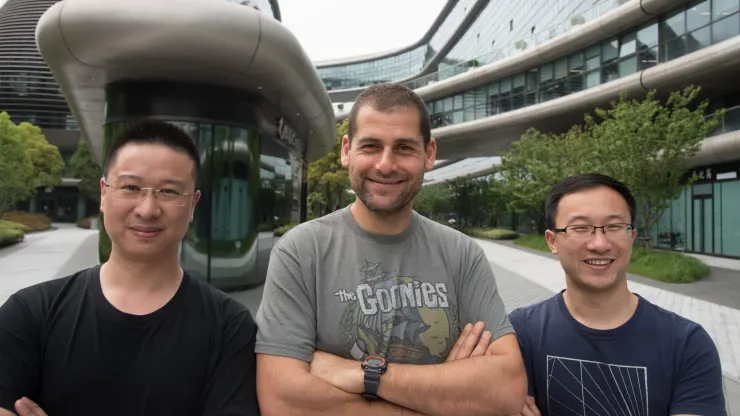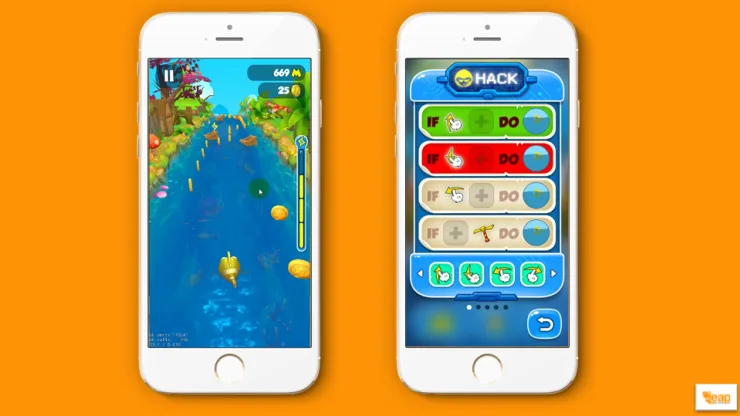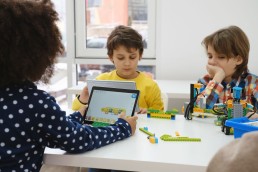Make your kids future-ready with Coding
We live in the digital era, where technology has become a crucial part of our day-to-day lives. Gone are the days when we could have survived being technologically laid back. AI, Robotics & Coding are the future of technology and innovation. Kids, being our future, must learn 21st-century skills to be future-ready.
Writing computer programs depends on calculations, which therefore requires an adaptable and scientific psyche. Showing kids the rudiments of programming code permits them to foster the speed of thought and the capacity to track down right and quick arrangements.
What is coding?
Firstly, we must understand what coding is. Coding is simply a programming language that a computer can understand. This content will advise the computer to act with a specific goal in mind, to do something specific, and to, at last, play out your desired activities - provided that your code is correct.
We talk a lot about coding, AI and Robotics, but is there a significant role of coding education in our child’s future?
Why should kids learn to code?
In today’s era, a large amount of the items we use have programming code set up. Each of our activities on the Internet happens as a result of recently composed code by somebody. When students complete school, their programming abilities will in any case be pertinent, and in particular, popular. By sending your kid to sort out the code, you cultivate their imagination in performing multiple tasks, however, you are additionally preparing them for their professions. Regardless of whether, after moving on from school, the children pick another forte, the abilities obtained during preparation will be useful to them in any of the areas that are important later on.
Apart from that, there are multiple other reasons why kids must be taught coding at an early age.
Building a Constructive Mindset: Coding is a complex field and writing excellent code requires us to follow some specific rules, concentrate, and have analytical thinking abilities.
When a kid faces a problem, they find creative solutions to simplify their tasks, thereby developing problem-solving behavior.
Provides space for Creative Imagination: Everyone is born with creative abilities and supplied with the right space and area of work. Coding, however, opens a platform for students to master the art of their creativity with simple blocks to text-based python codes.
It also expands the creative horizons of imaginative skills at an early age, where kids learn while having fun.
Creates awareness of the surroundings: While talking to a kid, we might realize that they know all the latest gadgets and smart devices around us. With their curiosity and determination to know things, coding can be a great area of creating awareness in children about the ever-evolving world. From Alexa to the cleaning bots, we are surrounded by smart technology all around. By concentrating on programming, a kid gets essentially fundamental specialized abilities, which are imperative in the computerized universe representing things to come in the future.
Helps build a better career in the future: Our tomorrow depends on the skills we learn today! In a competitive environment, a kid is supposed to have the fundamentals clear to represent themselves to the world. Being confident and well-articulated is just the icing on the cake, whereas having technological abilities are a plus for any career option your children choose.
Learning to code might seem formidable for kids but with software such as Scratch Jr, coding has been simplified while providing a visual dimension to our education system.
So, open your mind and get ready to code!
Children's Game Design: All You Need to Learn
It can be difficult to know how to encourage your child's interests in the best way, as any parent would argue. You might be considering if it's worthwhile for your kid to pursue a career in game design starting by learning the fundamentals of coding education. Keep in mind that game creation is a profitable career; game designers make, on average, $88,271 annually.
Your youngster can learn vital abilities like creativity, problem-solving, and critical thinking by pursuing game creation. No matter what career path they finally select, these abilities will be useful. Therefore, even if your child loses interest in game creation, encouraging them to pursue it can help them acquire valuable skills that will serve them well in the future.
Building cognitive and imaginative skills through game design is really beneficial. In addition to imparting useful skills that are applicable in many different industries, game design teaches youngsters how to consider other people's viewpoints. Entrepreneurs need this innate ability to create value, and it can be useful in virtually every job.
It's crucial to steer your children appropriately if they show an interest in game design. By instructing them on the fundamentals of coding and game development, you may assist them in leaping from ardent gamers to real game designers. They'll be able to translate their talent and enthusiasm into lucrative jobs with your help.
But why is Coding necessary?
The principles of coding and programming form the basis of game design. Kids should therefore be well-versed in these subjects before starting to build games. There are various tools at their disposal to aid children in learning programming and coding. With Jr. coding, kids as young as 6 years can start to learn coding with simple blocks.
Additionally, parents need to support and motivate their kids to research these subjects. To give feedback and direction, parents should also keep the lines of communication with their kids concerning game design open.
We will provide you with some useful suggestions to help your youngster grasp just what takes to become a better coder, which in turn can help them in honing their game design skills.
Play Video Games and Assess Gameplay
Children need to understand how games function as they become more and more common. By playing games, kids can learn to recognize patterns and discover which features and mechanics contribute to a game's enjoyment. Additionally, taking a closer look at a game from various perspectives can enable students to comprehend what makes a game engaging and compelling.
Furthermore, it's beneficial to expose kids to both good and bad games so they can figure out what makes one uninteresting or monotonous. Children can learn a lot about game design by playing games and dissecting them. The ability to solve problems is crucial for game designers. They can learn how to produce complex and interesting designs. Encourage children to reflect on things as they play video games. Help them practice coding, be it block coding, for the junior sections, to text-based complex coding & enable them to figure out what strategies and codes they need to build an interesting gameplay experience.
Using code to create games and stories
There are numerous fantastic options for youngsters to develop their coding skills and game-creation abilities. One way is through online classes that teach the fundamentals of coding through entertaining and engaging exercises. To allow children to learn while they play, these courses frequently include game design components, such as level creation.
LeapLearner is one such coding education platform where your child can register for a free demo session or sign up to get extensive coding education classes with expert trainers. The kids also get to practice and improve their coding skills to design, program and create games and stories.
Create Games Using the 4 Cs
Challenge, Change, Chance, and Choice are the four main game design components. To give players a fun and engaging experience, it is crucial to keep these factors in mind when building a game.
In order to keep players interested, challenges must be balanced to avoid frustrating or boring them. Choice gives gamers a sense of power and lets them tailor their experience to their preferences. Chance adds an unpredictable aspect that can liven up games while change keeps things interesting and eliminates monotony.
Alongside learning ways and techniques of game designing, children also learn and sharpen several academic and comprehension skills, such as concentration, teamwork, analytical thinking, and creative problem-solving.
These skills not only boost the confidence of the child but help them understand the fundamentals of coding and create complex games in the future.
Coding Education is the stepping stone to your child acquiring additional 21st-century skill sets that make them future-proofed with the World’s Largest Coding Education Company, LeapLearner.
Give a head start to your children’s Coding Education journey
No matter what seems to be your child's prospective future path, teaching them how to code will give them the edge they need to succeed, especially in today's tech-driven world. Your children will learn analytical, creative, problem-solving, and communication skills through programming. In addition to the skills your kids pick up along the way, it can be a lot of fun and a terrific way to use their energy.
Most successful geniuses started developing their abilities when they were very young. It's difficult to envision the amazing apps and tools that your children will create when they are much older if they are introduced to programming from an early age.
Making programming lessons entertaining and engaging for your children is essential because, at, say, 7 to 10 years old, they are a little too young to understand "if-then" statements. Excellent applications and games are readily accessible today to pique their interest and impart the principles through play and discovery. In other words, play is the best approach to teaching children.
Parents are advised to use the tried-and-true tools, apps, and strategies listed below to educate their children to code:
PROGRAMMING GAMES:Games are a great way to educate children of all ages on how to program, and they are ideal for very young children between the ages of 5 and 6. Kids can learn programming through games that focus more on animation and aesthetics than actual code. Block-based coding such as Jr. Coding helps kids below the age of 10 to understand simple coding through blocks while having fun. As they start making games and animated stories, it develops their interest in coding as well as improves their computational abilities and analytical thinking.
GRAPHICAL TOOLS: These programs offer an improvement above the more basic character manipulation apps. They include straightforward drag-and-drop interfaces with coding blocks to teach programming. With the help of these graphical tools, your children can access more recent events, variables, and commands to build games and animations by manipulating several objects. Block-based coding is the basic step towards coding, which later advances to text-based coding for kids in primary and senior grades. Once, the kids master the codes, they learn new and more complicated coding tools and programs such as Python. In addition to these straightforward games and drag-and-drop tools, more applications concentrate on the code itself and the visualization of its operation. For older children and adults looking to learn to code in a slightly less technical approach, the majority of these programs are excellent choices.
BOOKS ON PROGRAMMING FOR YOUNGSTERS:There are books on programming that have been designed with kids in mind. For learning specific coding languages, Python is a fantastic place to start, and several books can teach you the language. Several books cover programming in Scratch and Minecraft modding.
SPECIAL CAMPS AND COURSES: Programming-related special camps and courses are gaining popularity. All you have to do as a parent is looking for these camps and classes; a good place to start is at nearby institutions. LeapLearner is one such online Coding Education Company, where your kids can get in-depth coding Education, with their online one-on-one or group sessions.
BUT WHY EDUCATE CHILDREN IN CODING?
The logic and concepts of coding and programming are better understood by children when it is introduced to them at a young age. Some of the most well-known personalities in the IT industry, including Jobs, Gates, and numerous more, exhibit this way of thinking.
The world of the future is digital, so giving your child a solid foundation in analytical and problem-solving abilities will be crucial to his or her success in the future.
Technology is the future and your kids and students need to be ready for the future, with LeapLearner!
Why is coding education important in formative years?
Given the choice previously, would you have opted to learn to code?
Probably not, because we might have thought, why coding?
But as technology advances and the world is pacing toward digitalization, it seems almost impossible to be able to live without being tech-savvy. Kids are more innovative, quicker, and enthusiastic to learn new things than ever now. With evolving technology, advancements in education, and extracurricular activities, coding has emerged as a field to help kids learn to program their own games, stories, and whatnot.
What does the kid learn in Coding Education?
To understand why coding education is important for children, we must know what coding education teaches the kid and how it helps them to develop computational thinking and algorithmic Intelligence. With quick learning abilities, and an open mind to grasp information, and learn and hone important survival skills, children tend to equip easily with technology unlike us or our ancestors. They do not struggle with technology, rather they are curious to know what goes behind the toy they play with. This curiosity helps children learn to code at an early age, which helps them grow and achieve accolades in the future.
Our kids may move on to become successful and achieve their dreams without learning to code, but with the advancement of technology and the emerging buzz about AI and coding, it is almost impossible to not come across these in a few years.
Coding not only helps youngsters prepare for the future but also enables them to think, innovate and create. With additional logical and problem-solving skills, concentration, design thinking, and team building, they become well-versed with multiple software used for coding at early stages.
Coding: An asset for the kids to be future-ready!
For us, as parents, it is crucial to know the value of coding education during the formative years of a child. Coding education need not start with a challenging exercise, but rather with simple block coding software such as Scratch Jr.
Kids learn to code and design several animations, stories, and games with the help of simple block codes. It is fun and innovative for students with an interest in not only coding but STEAM Education as a whole.
Focussing on a large scale, STEAM education, also suggested by NEP 2020 is to be acquired into the CBSE curriculum. AI and coding education go hand in hand. While kids learn to code and program, they also open up to numerous inventive ideas.
Haven’t we all wanted our kids to not stick to their screens for long hours? But I guess there was no alternative to have them stuck on it for good. Coding provides a platform for all kids, starting from as early as 3-5 years to display their imagination to solve daily life problems and build programs with even complicated coding technology such as Python programming.
Young innovators ready to change the world:
With the growing technology and automation, is hard to explain why coding must not be a part of our children’s learning process. As hard as it may seem, it is enthralling to know that kids grasp better and excel in coding at an early age compared to an adult. Gradually, coding is seeping into the academic curriculum in schools, thereby providing each kid an opportunity to explore, experiment, and evolve through coding education. When the child begins to code at an early age, it opens up numerous gates for their careers as well as living skills. So, don’t wait, get Ready-Set-Code!
Why Israeli entrepreneur Ami Dror believes that every child must learn coding
In 2017, Israeli entrepreneur Ami Dror launched LeapLearner, an edtech company that teaches coding to one million students in 20 countries. As the startup enters India, the founder reveals why every child must learn this ‘language of the future’.
Ami Dror, Co-Founder and CEO of LeapLearner, a Cayman Island-based edtech company that teaches children to code and has recently forayed into India, has seen many seasons as an entrepreneur.
Father to three children, Ami is passionate about cultivating children's ability to be innovative. He has authored, Raising Future Innovators, a book that aims to give parents and educators the tools to raise the next generation of global leaders.

Ami’s first startup venture was the 3D Cinema industry front-runner, XPAND 3D. He initiated work on the first 3D TV technology and led the formation of a 3D TV licensing company, jointly owned by Sony, Samsung, XPAND and Panasonic. He is also the Co-founder of Zaitoun Ventures, a startup accelerator that helps startups across multiple sectors.
Earlier in his life, Ami served as a Captain in the Israeli Secret Service (Head of Security for Prime Minister Benjamin Netanyahu and President Shimon Peres) and a diplomat in Israel’s Ministry of Foreign Affairs. He is a Henry Crown Fellow at the Aspen Institute, a member of the Aspen Global Leadership Network, and a member of the Aspen Institute Moderator Corps.
Ami works closely with international non-profit organisations and is passionate about leveraging technology education to empower underprivileged populations across the globe.
With LeapLearner, he aims to empower children by teaching them how to code. With a presence in more than 20 countries, the startup offers courses like Block Coding, App Development, Advanced Python, Robotics, and AI for children between the age of five and 14 years.
The edtech startup kicked off its India journey in February this year with an office in Gurugram and appointed edtech entrepreneur Rahul Ranjan to head its India division. The company has committed an investment of $10 million in India and is now changing the way coding is taught to kids.
In a freewheeling conversation with YourStory, Ami talks about how LeapLearner came into being, why coding is important for kids, why LeapLearner is different, how he is driving LeapLearner in a time of crisis, and how education looks like in a post-COVID-19 world.
Edited excerpts of the interview:
YourStory (YS): Tell us about the genesis of LeapLearner. What was your eureka moment?
Ami Dror (AD): I learnt coding when I was about 10 years old. It was a very early version and was the foundation that shaped things later in my life. My daughters were introduced to coding in school at the age of eight and nine as coding is mandatory in Israel’s primary school system. Soon they developed an interest and wanted to learn more. I decided to teach them and started checking online sites, but the information was scattered and not suitable for children.
That is when I decided to start a LeapLearner in 2017, a company that would teach kids around the world how to code. It initially started in Israel and later moved to China, where we grew in an amazingly exceptional way.
In less than four years, the idea saw astounding growth: from teaching my kids to a million kids around the world. That's kind of amazing.
YS: Tell us about your offering before coronavirus hit us all.
AD: The platform had a bunch of offerings. We provided 1:1 tutoring online, prepared kids for the Olympics (in programming), and even worked with the governments of Israel, Nigeria, and Bhutan.
We also work with a lot of private and international schools, and offer them the LeapLearner platform, teaching tools, curriculum, and teacher training. This needs a teacher who knows how to teach and how to make coding fun and engaging. We are focused on project-based learning.
YS: How has LeapLearner grown since inception?
AD: LeapLearner was launched in 2017. In the first year, we were 100 percent devoted to R&D, with about 70 engineers working on the platform. During the first year, the company started with a few thousand kids; we moved on to tens of thousands and now teach one million kids. We started from Israel, went to China, and now we are present in over 20 countries and still growing.
YS: What are the age groups on LeapLearner, and how do your users learn coding?
AD: The students’ age ranges from five years to young adults. But, the majority are between five and 12 years.
The LeapLearner platform makes it extremely easy to code and see what you are doing. It is a big and complex learning system, and we keep improving it all the time. The curriculum was developed with teachers, based on inputs/feedback during training sessions.
We always have a teacher available because the problem with coding is that it is very easy to learn the initial levels with games etc, but you need someone to help with advanced coding. Just like math. The teacher sometimes teaches 1:1, in a group, or online, and then they take tests.
YS: There are various edtech companies offering coding courses? How are you doing it differently?
AD: LeapLearner is definitely the biggest company in the world in coding, innovation, and teaching how to code. There is no other company with global scale like ours.
We have a team of experts from universities around the world. There is a very standard way of how to teach coding, which was built for university students. We took that syllabus and converted it into project-based learning so that kids can develop their own projects versus we tell them what to do.
At present, we have a team of 30 people who create and keep improving the syllabus real time. We improve and change our syllabus with every piece of code, every scale, and with real-time feedback.
YS: Can you share a few examples of what you mean by project-based learning?
AD: A group of kids from China all got through Yale - they had developed a management system using coding for their school and this project was one of the reasons they qualified for Yale. We have another group that went through Stanford with a similar story.
There are kids who developed small software for their family business and little shops. We have kids who did their science research with the help of coding. A girl developed painting software because she is an artist. In China, more than 1,000 children developed a game together, a running game.
YS: Tell us about your India plans.
AD: India is our most recent global expansion. Since we launched LeapLearner, it was very clear to us that the most important markets for the company would be India and China. We got to China early and now India.
India is growing as fast as China. We launched a few months ago and already have more than 10,000 students. Why India? It is very obvious: education is taken very seriously in India. The families here are very similar to those in Israel and China.
There is a very strong need for digital education and people understand that coding is the language of the future.We have so far invested $ 10 million in India and will keep investing as it is a very important market.
YS: Why do you think kids should learn to code?
AD: Coding is a language, and is as important as math, English, or any other subject. It is the only way to communicate with technology. It is essential for every child to know coding because it is the language of the future.
Everybody knows this language, but we do not know how to read and write in it. While using technological machines and devices, you are speaking “robotics”, you are interacting with the technology. So, the people who can read and write the technology are actually designing the technology of the future.
There will be a great barrier between the people who will actually design the future and those who will just use technology created by others.
YS: What is the potential of learning to code in a country like India?
AD: It’s not only about India. Every child in the world, no matter what s/he wants to do or be - a basketball player, chef, lawyer, or author – needs to know how to code.
The goal is not to become a genius, but to know because this is the only way in which you can interact with and create technology.
YS: How has COVID-19 impacted LeapLearner’s journey?
AD: LeapLearner has a very strong online offering globally, but we had planned to rollout the online business from summer. The team was running pilots already and we were able to shift most of our existing students online when the lockdown started. We have also been growing our customer base by about 30 percent week on week.
Our online offering was always live 1:1 classes. Realising that a large number of students might not be able to afford the same due to high unit costs, we have introduced live online group classes while maintaining a high degree of student engagement and teaching-learning effectiveness. This has allowed us to broaden our reach from a target group perspective.
Apart from our core offering, we have also helped many schools set up online classes free of cost. We were able to create quick and simple solutions for schools to take teaching-learning online, thanks to a strong global tech team. We are currently doing about 150-200 demo classes a week.
YS: Given that coronavirus isn’t going away soon, what future do you see for LeapLearner?
AD: One of our biggest business drivers was B2B2C partnerships with K-12 schools and after-school centres. Before COVID-19, we would generally have trainers being physically present inside the classroom with children in groups of 20-25.
After the scheduled summer break, we will need to look into alternative methods of offering our computational thinking courses in coding and robotics for group classes.
A live online class framework, clubbed with innovative pedagogy of student engagement and measuring of learning outcome, is being developed for school-based classrooms.
This Chinese-Israeli start-up wants to change the way kids learn to code
LeapLearner, a Shanghai-based education start-up, aims to teach children as young as five years old how to code and then some.
The start-up’s main service might be a platform that educates children on programming, but its ultimate goal is to impart skills needed in the future to children, LeapLearner’s co-founder and CEO Ami Dror told CNBC in an exclusive interview.

“Coding is just a tool,” Dror said, adding that he sees the learning process of coding as instrumental to teaching children how to innovate and problem-solve.
Dror, a fellow at the Aspen Institute-linked Aspen Global Leadership Network, taught himself to code as a child. The entrepreneur was head of security for an Israeli prime minister and dabbled in the consumer 3D space in the past. Also part of LeapLeaner’s founding team are Aaron Tian, a popular mathematics tutor in China, and Leo Zhao.
There are around fifty people working at LeapLearner, Dror told CNBC. Half of that team have backgrounds in gaming and focus on the technological aspects of the start-up, while another team focuses on the educational side of the business.
The edutainment start-up also counts several illustrious names among its backers. Dror said that Honeywell President for Global High Growth Regions Shane Tedjarati and former Alibaba CTO John Wu are among early stage investors in the company.
It was Wu, who acts in the capacity of an adviser, that convinced him to launch LeapLearner in China, Dror said. Wu also ensures that what the start-up does is scalable in changing the way people learn, Dror added.
Combining a series of online and offline platforms, LeapLearner works on a cycle that involves three weeks of self-learning followed by a hackathon.
During the first three weeks, children learn aspects of coding on their own at home. First, children are exposed to code used in games they play by being allowed to change variables in the code of those games. For example, in a game like Pac-Man, children can “hack” the game by switching up the ways characters appear on the screen: pac-dots could be changed into bananas and Pac-Man could turned into a pet dog.

Once they understand variables, the children move on to practicing through natural language programming 一 a way of programming in the style of human language. When the child has mastered that, they move on to the coding platform itself, where they get to code with Java Script.
After the self-learning process is complete, the children gather in the fourth week for a hackathon where they meet other LeapLearner users in person and compete in teams to create games of their own.
In Dror’s words: “It’s not a game 一 it’s an educational platform.”
Besides the offline aspect of learning, LeapLearner differs from existing players in the coding education space because of how it is tailor-made to sustain engagement among children.
Some platforms, such as the Massachusetts Institute of Technology-developed Scratch — which uses blocks instead of words to allow users to program — make it easy to get kids involved in basic coding, but children stop using it when coding becomes more advanced, Dror said.
“It’s like learning engineering with Lego,” he added.
On the other hand, offerings from institutions like the Khan Academy can be too dull for younger users.
“The problem with Khan and Codeacademy is that the kids’ engagement is very low as both companies teach how to code with classroom-like tasks,” Dror said, adding that LeapLearner circumvents this by by teaching children through the process of developing video games.
For now, LeapLearner will only be launching in Shanghai, before being rolled out across greater China and Asia Pacific. Dror said the start-up will subsequently expand to the Middle East and South American markets as investments in education in those regions are high and demand for innovative, high quality educational products is strong.
The Beta version of LeapLearner will be available on April 25, while the platform opens to the public in Shanghai on June 1. Dror said that he is targeting 5,000 users in Shanghai before rolling LeapLearner out to the rest of China.
As for its pricing model, Dror said users would pay an annual “tuition” fee, of which there are several price levels to choose from. Pricing would be “more like school tuition … and less like buying an online service,” he added.
LeapLearner has currently secured $5 million in seed funding, of which 10 percent comes from Zaitoun Ventures, an Israeli-Palestinian investment firm that Dror co-founded.
While he preferred not to disclose LeapLearner’s target for its next round of funding, Dror noted that the start-up was looking at a “big round” for the end of the year.
LeapLearner, the World's Largest Coding Education Company, Launches in India
LeapLearner India joins the company's global network of over 1,000,000 students located across 20 countries, including China, Israel, and the US.
2020 kicked off with the launch of LeapLearner India, the EdTech giant's most recent global expansion into a new and promising market. The company will be based out of Gurugram and managed by Indian EdTech entrepreneur, Rahul Ranjan. LeapLearner International's Co-Founder and CEO, Ami Dror, will also serve as Chair of the global corporation's Indian enterprise. Dror, an Israeli serial entrepreneur, moved to Shanghai in 2016 to launch LeapLearner in China together with renowned mathematics education expert, Aaron Tian. The company has since reached over a million students through their online and offline offerings for the acquisition of 21st century skills.
Following the extreme popularity of their cutting-edge computational thinking courses in China, LeapLearner India will now offer this curriculum for students ages 5-14 across India. Through LeapLearner's uniquely designed platform and learning tools, children will learn coding languages such as Scratch and Python, as well as App Development, AI, Robotics & Machine-Learning. The company's pedagogical approach and intuitive learning platform have been customized for Indian teaching-learning methods.
In less than two months prior to the company's launch, LeapLearner India already registered over 1,500 students. The company plans to onboard over 10,000 students in its first year of operations. In addition to one-on-one online lessons, courses will be available at over 40 learning centers and ten K-12 Schools. As LeapLearner India grows and expands its activities, the company will enable top-rated teachers to offer home tutoring and small-group offline classes as well.
As an impact-focused company, LeapLearner has joined forces with ICode, a US-based non-profit focused on expanding opportunities for computational thinking education through local, national and international junior coding competitions. LeapLearner students will be certified by ICode and will also be invited to participate in ICode's upcoming India Junior Coding Competition in October 2020. Through this competition, LeapLearner students in India will join the more than 80,000 students that have participated in ICode competitions around the world. Top achievers may even find themselves invited to attend ICode's Global Coding Olympiad in Shanghai in the Summer of 2021.
About LeapLearner
LeapLearner is World's Largest Coding Education Company with over 5,00,000 Students across 20 Countries. In India we offer Computational Thinking Program through Courses in Coding, Robotics, App Development, IoT & Logic for aged 5-14 years.
Photo- https://mma.prnewswire.com/media/1086497/Rahul_Ranjan_and_Ami_Dror.
(This story has not been edited by Business Standard staff and is auto-generated from a syndicated feed.)
Press Release
World’s #1 and largest K12 Coding Education Company LeapLearner launches its Malaysia operations in partnership with Zavy Technologies. With over 1 million students in more than 20 countries, LeapLearner offers Coding Education courses for ages 5-16 years on its proprietary platform.
It’s unified and intuitive platform allows multiple courses like Blocky, Python, Java Script and App Development to be taught on a single platform. Designed to enable and empower K12 Education systems to equip young children with Computational Thinking skills, LeapLearner’s platform is used by Public School systems, Private International schools, and After-School learning centres along with thousands over students learning directly online.
 Rahul Ranjan, Co-Founder and Head of Global partnerships said, “We view Malaysia as an important demographic region in our quest of Coding education for all. A fast growing young population clubbed with strong desire to excel in future makes the Malaysian student community the right cohort for using the LeapLearner platform and prepare themselves for the future world of Artificial Intelligence, Machine Learning and Data Sciences. ”
Rahul Ranjan, Co-Founder and Head of Global partnerships said, “We view Malaysia as an important demographic region in our quest of Coding education for all. A fast growing young population clubbed with strong desire to excel in future makes the Malaysian student community the right cohort for using the LeapLearner platform and prepare themselves for the future world of Artificial Intelligence, Machine Learning and Data Sciences. ”
 Huijun ( Aaron) Tian , Co-Founder and CEO , LeapLearner China says “We at LeapLearner are
Huijun ( Aaron) Tian , Co-Founder and CEO , LeapLearner China says “We at LeapLearner are
excited about offering the LeapLearner platform to the children in Malaysia. LeapLearner supports multi-cultural and multi-language education systems across more than 20 countries Globally.
 Vasantha Malar, the CEO of LeapLearner Malaysia and Founder of Zavy Technologies said “Our mission is to make coding easy and equitable , shaping the minds of the kids to use computational thinking to solve problems. Our children are exposed to a range of online content which diverts their focus from learning. LeapLearner is designed to bring back that focus on learning by making the whole experience fun and engaging. The skills they gain from using the LeapLearner platform to code are also beneficial for learning other subjects in schools besides solving day to day problems. They will be equipped with high-demand skills in the digital world”
Vasantha Malar, the CEO of LeapLearner Malaysia and Founder of Zavy Technologies said “Our mission is to make coding easy and equitable , shaping the minds of the kids to use computational thinking to solve problems. Our children are exposed to a range of online content which diverts their focus from learning. LeapLearner is designed to bring back that focus on learning by making the whole experience fun and engaging. The skills they gain from using the LeapLearner platform to code are also beneficial for learning other subjects in schools besides solving day to day problems. They will be equipped with high-demand skills in the digital world”
LeapLearner Malaysia plans to add over 5,000 students in next 12 months, during its pilot program. It is planning to offer this through K12 School systems, Individual micro-entrepreneur network of educators and directly online. Tutors and digital entrepreneurs not only impart knowledge but also help mould out future generations with the right characters and ethics. LeapLearner digital entrepreneurs will bridge the urban rural digital divide !
 About LeapLearner: LeapLearner is the world’s largest coding education company with over 1 million students across 20 countries. LeapLearner provides coding education for Malaysian children aged 5-16 years old.
About LeapLearner: LeapLearner is the world’s largest coding education company with over 1 million students across 20 countries. LeapLearner provides coding education for Malaysian children aged 5-16 years old.
 About Zavy Technologies: Zavy Technologies is an innovative IT and Business consulting firm that provides business development consultancy, project and strategy management services, business outsourcing and IT solutions to various industries.
About Zavy Technologies: Zavy Technologies is an innovative IT and Business consulting firm that provides business development consultancy, project and strategy management services, business outsourcing and IT solutions to various industries.
For more free demo or further details on LeapLearner Malaysia, please contact us at +6 010 432 2484. Email us at info.my@leaplearner.com / contactus@zavytech.com.
How to Get Your Kids Interested in STEM Learning
Children have the capability to learn complex subjects at a very early age. In fact, many kids understand science, technology, engineering, and maths (STEM) when they are around one year old. However, this capability and curiosity of learning and understanding needs to be preserved and prevailed as a child grows.
In order to teach your kids to STEM at an early age, you need to allow them to analyze, question, and develop a sense of curiosity about their surroundings.
Nevertheless, neither the school system nor the parents realize the value of stimulation a child needs in order to develop these critical skills. In India, most schools don’t even have a curriculum for teaching children the basics of STEM. Since they are not introduced to science, technology, engineering, and maths at an early age, children tend to grow weary and afraid of these subjects when they have to finally face them in upper standards. As a result, we see most children avoiding anything related to STEM and choosing a different career altogether.
According to the National Research Council, kids develop ideas about their social, biological, and physical surroundings and their functionality before they are enrolled in school. However, once they enter the school system, their pre-developed ideas are not paid any heed to, and the kids are essentially indoctrinated.
Let’s see why it is essential to build upon the ideas of children rather than starting a new:
Setting the stage
Stem stands for science, technology, engineering, and maths. While the school system covers science and maths, children are not introduced to engineering and technology, as needed for their proper cognitive development. Sometimes, children don’t learn about engineering and technology until they are in middle or high school.
According to many researchers, STEM education is vital for kids to develop an analytical mind and to narrow the gap between children’s cognitive achievements. Moreover, exposing children to such complex subjects helps them solidify their careers.
Since 1990, there has been a 79% rise in employment in STEM fields. Moreover, compared to non-STEM employees, STEM occupants earn up to 26% more on average.
However, unfortunately, adults tend to curb their kids’ enthusiasm about STEM subjects by disapproving of their interests and being absent when the kids seek support to further their interests.
As a caring adult, one needs to be supportive of their children’s dreams and enthusiasm. Good parents allow their kids to be curious and ask questions about their surroundings, thereby giving them positive reinforcement that they are on the right path.
How can one encourage their kids to gain an interest in STEM?
Stimulate your child’s curiosity with science
There are a million science-based projects you can do with your kids that are not only simple but also fun and entertaining. Here are some of the activities:
- Explore: As a kid, everything about the world seems exciting and awakens a sense of curiosity. Taking your kids out on a walk or on a trek would not only help you establish a stronger connection with them but also teach them about nature. From soil, rocks, mountains, and trees, there are a lot of things to learn about in the outside world.
- Let your kids interact with animals: If you have a pet dog or a cat, chances are your kids are already very friendly with them. You can try teaching them more about the animals that they encounter in their daily lives. It will help your kids develop compassion and empathy as well and make them friendly in their approach. Moreover, learning about how different animals fare in their environment is always a plus point from a biological perspective.
- Encourage your child to ask questions: This point can’t be stressed enough. One of the atrocities that parents do with their children is to give them specific information as irrefutable facts. In order for kids to learn new things and build a sense of skepticism, they need to put a question mark at everything. As parents, you are supposed to do your best to answer every query they throw at you in a comprehensible manner.
- Give your child four ways to play: There are four different types of play to help your kids develop a scientific mind. These pretend play, exploratory play, guided play, and free play. Pretend play is when the kid uses their own imagination and exploratory play is when kids learn by experimenting with objects. Guided play is when there is an adult involved, and free play is when kids play on their own.
- Conduct fun experiments: There is a lot of fun and simple experiments you can perform with your child, including lava lamp, creating a leak-proof bag, and walking water.
Teaching Tech with Technology Activities
With technology activities, kids learn to employ technology to solve problems. Here are the following ways you can help your kids learn more about technology and its applications:
- Cut shapes out with scissors: Draw several shapes on a piece of paper, and under attentive guidance, ask your kids to cut out those shapes with a scissor. This will help them develop an artistic mind and apply their cognitive abilities in a precise manner.
- Build a house of cards: Building a house of cards with your kids allows them to learn about architectural design and how to go around building objects that are dependent on each other. Once your kids have mastered the ability to build a house of cards, make it more challenging by adding coins and other weights.
- Play logic games: Indulge in some brain teasers, puzzles, and logic games with your kids to develop their problem-solving skills. Such games help them learn new ways to interpret a problem and find different solutions to it.
- Have them play with blocks and shapes: This is more of a visual exercise. Give your kids differently shaped blocks (triangles, squares, etc.) and ask them to put them in similar-looking gaps. It will teach your kids the value of symmetry and functionality, which plays a vital role in technological development.
- Create treasure hunt maps for your kids to play: You can do this indoors as well as outdoors. Place some rewards at certain points in your house and create a map with clues around. Ask your kid to hunt for the rewards using the map as their guide. This game not only teaches your kids to be cognitive, but it also teaches them to be independent.
Entertaining with Engineering
Using technology to solve problems helps kids a lot in their growth, but it also raises a question in their minds: Why and how can certain technology help them in their endeavors? This is where the engineering part of STEM kicks in. Since the school system does not introduce any subject close to engineering, at least until the kid is in middle school, as a parent, you need to take it upon yourself to make your kids aware of engineering. Here are a few ways you can introduce engineering to your kids in a fun and interesting way:
- Teach them about levers and pulleys: Levers and pulleys are some of the most basic machines in engineering. When kids learn about these objects, they understand engineering is basically using machines to make day to day tasks easier. Moreover, levers and pulleys can be easily developed and used in real-world scenarios, which encourages kids to build their own mechanical objects.
- Plan and design a structure: Provide your kids with Lego blocks and let their creativity soar. Teach them to create basic structures such as a table and a chair and then let them develop on that concept to build something of their own.
- Build a ramp: Like building a structure, building a ramp will help your kid understand the importance of angles, height, and weight in building objects. They can use their remote-controlled cars to drive on the ramp.
Make Maths Amusing
Many children are afraid of mathematics, especially when they are in higher standards. The reason for this fear is deep-rooted in their inability to understand the subject because they were never introduced to maths at an early age. You can have your kids participate in certain activities to curb this fear of maths and make them interested in the subject. Some of the math-centric activities for kids are as follow:
- Baking: While baking, kids learn the importance of counting and using the right amount of ingredients for the cake to come out perfect. This way, they learn that numbers and measurements are essential not only in maths but in everyday life.
- Pretend-play with monetary value: You can either pretend to be a customer or a cashier as long as it includes monetary value. Use the game to teach the kids about addition, subtraction, division, and multiplication.
- Play math games while waiting: Kids are too easily bored and are always looking for something interesting to do. When you are waiting with your kids or driving with them to someplace, you can play addition and subtraction games using real-life examples. For instance, ask them how many ice creams they want and how many would they have left if you took two out of all their ice creams. Take turns at answering questions, so your kids feel at equal grounds and not like they are being interrogated.
STEM can not only be taught to kids at an early age, but it can be a part of their life throughout their academic career and beyond. The earlier you start introducing your kids to these concepts, the better they would develop their cognitive and analytical skills. Nevertheless, make sure you are teaching science, technology, engineering, and maths in a fun way and not in a daunting manner, lest you want your kids to repel STEM concepts.
Whether or not your kid chooses to pursue a career in the STEM field is their own decision. However, at least they would grow smarter and have the proper problem-solving skills at their disposal in every aspect of their lives.
Choosing between Graphical vs Text-Based Coding for Kids
As parents, we are often confused about how we can teach our kids to code and how we can approach them with the proposal. Well, we are living in a rapidly changing world, and that means teaching coding to kids has been made easier through the years. Now, we have graphic-based coding languages that can easily be understood by kids as young as five years old.
Graphic-based coding helps lay down the foundation of programming for kids by visually introducing them to all the essential coding elements. Once kids have gotten the gist of how programming works, they can easily transition to more advanced, text-based coding methods.
Let’s first understand the difference between text-based coding and graphical coding so we can better explain why and when graphical coding is a better choice for kids.
Difference between Graphical Coding and Text-based Coding
While most computer languages are text-based, there are a large number of graphical languages as well.
Graphical-based languages are the ones that allow coding through graphical manipulation of program elements. It allows programming through visual context, arranging text and graphics in a specific order in the given space. For instance, one of the most famous graphical languages, Scratch, uses boxes of commands that can be placed in a particular order to conduct a program.
Text-based coding languages, on the other hand, rely on texts, symbols, and syntaxes to be written as lines of code. Kids below a certain age (below 11-12 years) are more likely to adopt graphical coding than text-based coding.
Why Graphical Coding is Best for Kids
Graphical coding has several advantages over text-based coding classes for kids. Let’s take a look:
Readability
Graphical coding languages such as Scratch and Blockly employ blocks to make it easier for kids to understand coding. Using graphic-based languages, kids can create projects using the block-like interface. It allows more readability for those who are just starting to learn to code.
Newbies prefer block-based programming over text-based ones over their ease of use and resemblance with the English language.
Easy to Use
Continuing on the first point, graphics-based coding is easier to use because of its visual representation of elements. When the language is put in a graphical context, it removes the guesswork and makes kids go at it with their own ideas and concepts. Moreover, with graphics-based coding, kids don’t have to remember a list of commands and can go on programming with everything provided for them at their screens.
Typing
Since text-based programming requires typing, there is a high chance that one might make mistakes while writing the code. Computer languages are very stringent when it comes to coding. Every character, alphabet, or symbol can drastically change the way the program works, and therefore, it is critical to type all the characters in perfect order. However, it could be challenging for kids to write long lines of code without any mistakes.
This is why graphic-based coding is more preferred for kids. It provides essential coding elements without having to break down the code into text. It is easier to go through and apply without having to worry about making mistakes.
Graphic Based Coding is Not Dumb
Professional coders often assume that graphics-based coding is a dumbed-down version of programming. While it is true to a certain degree, it is not entirely right to deem graphical coding as dumb.
Graphical-based coding removes the irrelevant and unnecessary elements from programming to help kids get an overall idea of coding without getting them intimated. The aim of visual coding is to get kids interested in computer programming first. As soon as kids learn the basics of programming and what elements coding constitutes, they can transition to more advanced coding practices.
Suggested Read: Your Child Should Learn Coding but not to become the next Zuckerberg or Pichai
Technical Know-How
As mentioned in the previous point, graphics-based coding introduces kids to the world of computer programming in a friendly and non-intimidating manner. Kids learn all the basic elements that go into computer programming through block-based coding so they could later try their hands at text-based coding without having to worry about learning the basics.
Preference of the Kids
Kids learn more through what they see, observe, and practice. Therefore, we must introduce new concepts and ideas to them in a way that they enjoy and can entertain themselves. Graphical-based coding teaches kids coding through gamified and visual mediums. This helps kids gain interest in the world of computer programming rather than running away from it.
Text-based coding can seem redundant and dull. Moreover, kids, more often than not, wouldn’t want to sit in front of a computer and type a long list of commands. Nevertheless, with graphics-based coding, kids can see all their actions come alive right in front of their eyes.
Conclusion
In a world where coding is inevitably becoming an essential part of life, one must get started with it somewhere. Graphic-based coding is the best way to get introduced to computer programming, not only for kids but also for adults who are looking to learn computer languages. Not to say that graphical coding can replace text-based coding, but it can provide you with the stepping stone towards a more skillful life and a successful career. Kids below a certain age (below 11-12 years) are more likely to adopt graphical coding than text-based coding.









